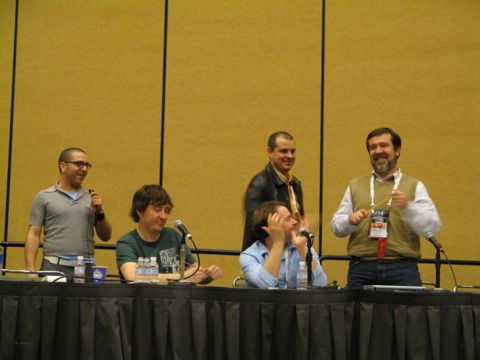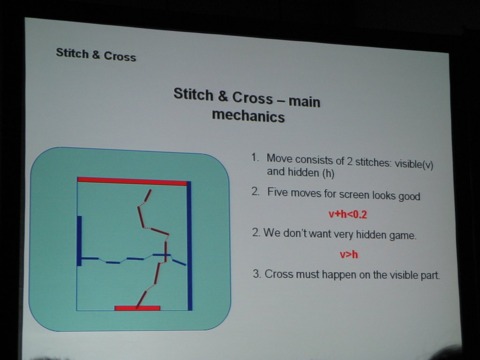GDC 07: Game Design Challenge threads the needle
This year's session asked a trio of industry luminaries to imagine a game played with fabric, thread, and a needle; see what they came up with inside.

SAN FRANCISCO--The age-old activity of sewing hardly seems like a natural fit for next-gen console gaming. But at the Game Developers Conference's annual Game Design Challenge session, unusual ideas are precisely the point.
Last year, participants were asked to envision a game that could win the Nobel Peace Prize; the year before that, the challenge was to create a game design based around the works of Emily Dickinson.
This year's challengers: game design luminaries Alexey Pajitnov (Tetris, Hexic), David Jaffe (God of War), and defending champ Harvey Smith (Deus Ex, System Shock). Their task: Design a game played with fabric, thread, and a needle.
Panel moderator Eric Zimmerman (gameLab) specified that built-in sensors would detect which thread was in use, and when and where the needle was passing through the fabric. However, one constraint was that the sensors would not be able to detect folds or recognize gestures. The three challengers were given two months to develop a design and then 10 minutes each to present their ideas. They were also asked to step the audience through their design process.
As in previous years, the results were both zany and provocative. All three designers were warmly received, but the audience ultimately crowned Pajitnov the new champion.

Pajitnov's winning design, Stitch & Cross, is a simple two-player game in which the player tries to cross a rectangular game board before their opponent. Players start on perpendicular sides, and moves are made in real-time by stitching the fabric interface with different lengths of thread and with different needles. The player can send their opponent back to the start by "crossing" their opponent's stitch.
In contrast with the other two panelists, Pajitnov focused on creating a consistent and complete rule set. After presenting his overarching vision, Pajitnov addressed problems with his initial design and offered solutions. For example, to prevent moves from becoming too predictable, Pajitnov proposed two types of stitches: hidden stitches that would be shorter but impervious to crossing, and visible stitches that would be longer but vulnerable. He also suggested melting away the tale of the stitched path to reduce vulnerability, as well as adding obstacles to differentiate each level.
By the end, Pajitnov had identified nine rules and numerical relationships that encompass all the gameplay mechanics.
Jaffe's design, Playper, was perhaps the most conceptual of the three designs. In Playper, the player uses a special fabric with paperlike qualities to fold and sow paper airplanes. The needle position and stitch locations create virtual paper airplanes that can be thrown through a virtual obstacle course. Jaffe explained, "I didn't want to do anything you could do with [another interface]."
Jaffe envisioned that the core "fun" of the game would lie in the iterative design cycle of stitching together the physical airplane, testing them in the virtual environment, and then returning to the physical model to tweak the virtual behavior. He also suggested that players would browse each others' planes over the Web, compete on leaderboards, and buy customized add-ons to stitch into their planes.
Smith presented the most ambitious design of the session, proposing a physically simulated 3D adventure game called The Tailor's Daughter. Armed with a magic needle, Noah (the protagonist) journeys through an ancient kingdom to save her father. Battles are fought by Noah's stuffed animal companion, and players find new needles and fabric pieces that can be stitched onto the stuffed animal for power-ups. Players open portals by stitching them in the fabric, and they can close those portals to prevent monsters from following. Smith also imagined that players would move around the world by poking the fabric at different places.
Smith also shared a detailed vision for the design of the fabric-and-needle controller. Citing Shigeru Miyamoto as a personal hero, he reiterated that designers should "always think about the controller from day one." Smith revealed, "Until I could visualize the controller, I had trouble designing a game." Ultimately, Smith settled on adapting the lap loom, a familiar object which already "maps to the living room." In the center of the device, the special fabric would be stretched over a frame. On each side of the device, small screens would show minimaps or options. Smith envisioned that the device could be flipped over to control the character in a different way or on a different scale.
Despite an overwhelmingly playful atmosphere throughout the session, the panelists did face tough questions from the audience. One attendee, commenting that sewing has typically been a female-dominated activity, asked Zimmerman why no female game designers had been invited. Zimmerman responded that "gender was not the primary factor for inclusion."
Zimmerman explained that each year's challenge is designed to simultaneously parody and pay homage to buzz topics in the industry. This year, the topic was inspired by the recent success of alternative gaming interfaces used in games like Wii Sports and Guitar Hero.
As in previous years, Zimmerman concluded the session with a short motivational speech. "There's nothing stopping us from conceiving of [such] games," Zimmerman reminded the audience. He urged, "It's up to us--all of us here at the GDC this year--to make our industry better."
Got a news tip or want to contact us directly? Email news@gamespot.com
Join the conversation